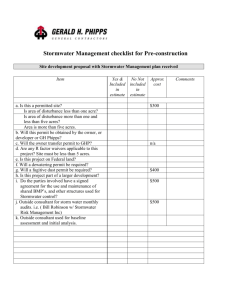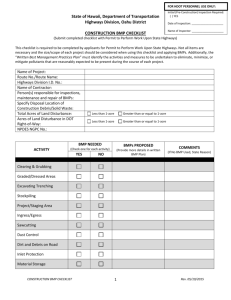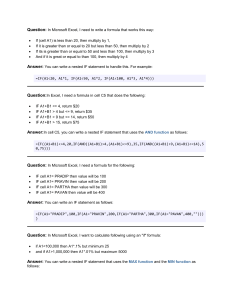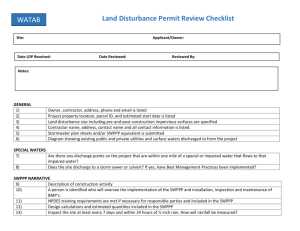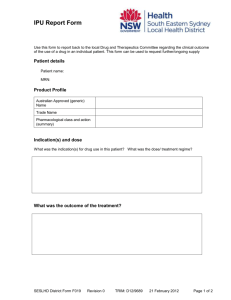Constructed Wetland - Minnesota Stormwater Manual
advertisement
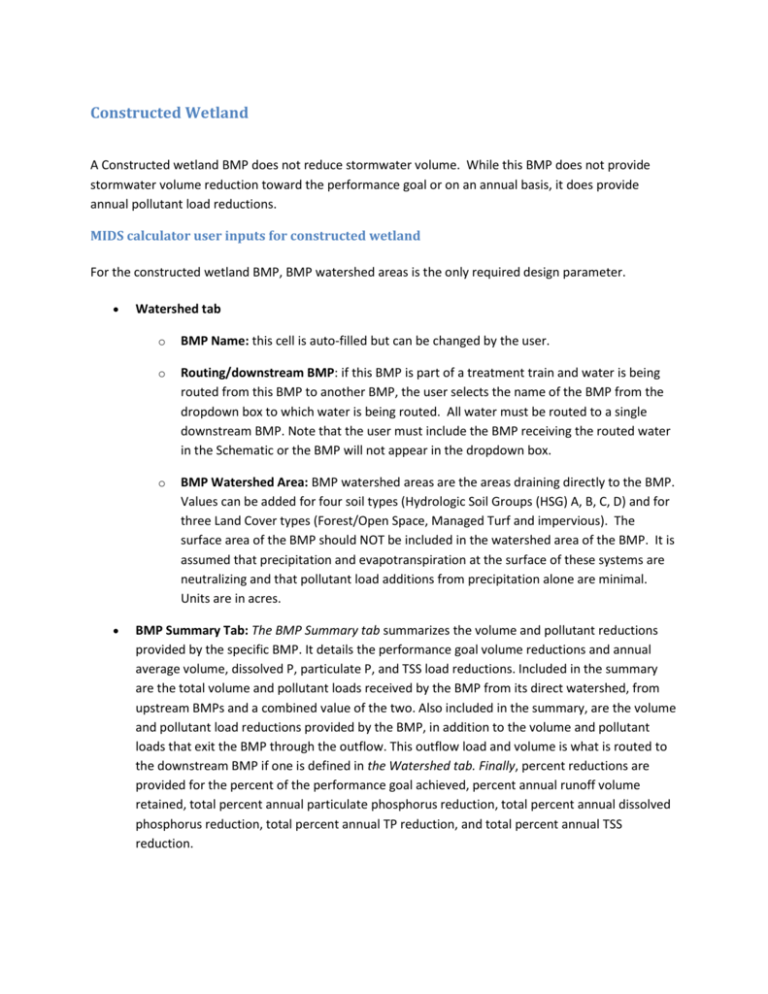
Constructed Wetland A Constructed wetland BMP does not reduce stormwater volume. While this BMP does not provide stormwater volume reduction toward the performance goal or on an annual basis, it does provide annual pollutant load reductions. MIDS calculator user inputs for constructed wetland For the constructed wetland BMP, BMP watershed areas is the only required design parameter. Watershed tab o BMP Name: this cell is auto-filled but can be changed by the user. o Routing/downstream BMP: if this BMP is part of a treatment train and water is being routed from this BMP to another BMP, the user selects the name of the BMP from the dropdown box to which water is being routed. All water must be routed to a single downstream BMP. Note that the user must include the BMP receiving the routed water in the Schematic or the BMP will not appear in the dropdown box. o BMP Watershed Area: BMP watershed areas are the areas draining directly to the BMP. Values can be added for four soil types (Hydrologic Soil Groups (HSG) A, B, C, D) and for three Land Cover types (Forest/Open Space, Managed Turf and impervious). The surface area of the BMP should NOT be included in the watershed area of the BMP. It is assumed that precipitation and evapotranspiration at the surface of these systems are neutralizing and that pollutant load additions from precipitation alone are minimal. Units are in acres. BMP Summary Tab: The BMP Summary tab summarizes the volume and pollutant reductions provided by the specific BMP. It details the performance goal volume reductions and annual average volume, dissolved P, particulate P, and TSS load reductions. Included in the summary are the total volume and pollutant loads received by the BMP from its direct watershed, from upstream BMPs and a combined value of the two. Also included in the summary, are the volume and pollutant load reductions provided by the BMP, in addition to the volume and pollutant loads that exit the BMP through the outflow. This outflow load and volume is what is routed to the downstream BMP if one is defined in the Watershed tab. Finally, percent reductions are provided for the percent of the performance goal achieved, percent annual runoff volume retained, total percent annual particulate phosphorus reduction, total percent annual dissolved phosphorus reduction, total percent annual TP reduction, and total percent annual TSS reduction. Methodology Required Treatment Volume The required treatment volume, or the volume of stormwater runoff delivered to the BMP, equals the performance goal (1.1 inches or user-specified performance goal) times the impervious area draining to the BMP. This stormwater is delivered to the BMP instantaneously following the Kerplunk method. Volume Reduction This BMP does not provide volume reduction toward the performance goal. Pollutant Reduction Pollutant load reductions are calculated on an annual basis. A constructed wetland BMP does not provide annual volume reduction. Fixed removal rates of 68 percent total suspended solids (TSS), 0 percent particulate phosphorus, and 0 percent dissolved phosphorus are applied to stormwater runoff that enters the constructed wetland. NOTE: The user can modify event mean concentrations (EMCs) on the Site Information tab in the calculator. Default concentrations are 54.5 milligrams per liter for total suspended solids (TSS) and 0.3 milligrams per liter for total phosphorus (particulate plus dissolved). The calculator will notify the user if the default is changed. Changing the default EMC will result in changes to the total pounds of pollutant reduced. Routing A constructed wetland can be routed to any other BMP except for a green roof and a swale side slope or any BMP in a stormwater treatment sequence that would cause stormwater to be rerouted back to the constructed wetland already in the sequence. All BMPs can be routed to a constructed wetland except for a swale side slope. Assumptions for constructed wetland The following general assumption applies in calculating the credits for a constructed wetland. If this assumption is not followed, the pollutant reduction credits cannot be applied. The constructed wetland has been properly designed, constructed and will be properly maintained. On the watershed tab, the following warning is given: “The calculator does not require sizing inputs for non-volume reducing BMPs. This BMP should be sized according to the guidelines in the MN stormwater manual.” Design and construction criteria can be found at this link. Images Symbol for wetland in MIDS calculator BMP watershed area parameters

